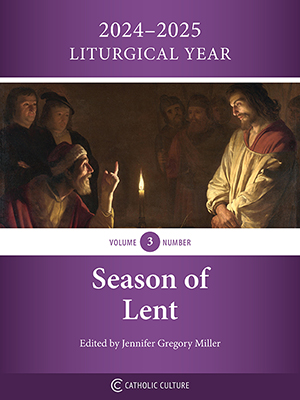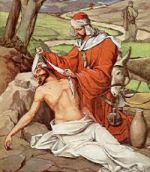The Luminous Mysteries: Knowing Jesus in His Public Ministry
By Dr. Jeff Mirus ( bio - articles - email ) | Jun 06, 2008
When Pope John Paul II proposed a new set of mysteries of the Rosary in 2002, he wished to make the Rosary even more into a compendium of the Gospel. The Pope pointed out that the traditional Joyful, Sorrowful and Glorious mysteries, while commemorating signal events in salvation history, tended to ignore Our Lord’s public ministry. Yet it was through His public ministry that Christ primarily revealed both His own identity and His invitation to enter the Kingdom of God. In this sense, Our Lord’s public ministry is truly luminous.
The Other Mysteries
The Joyful Mysteries, for example, cover the conception, birth and infancy of Our Lord, along with the one episode we have from when He was twelve years old. The Sorrowful Mysteries focus on His passion and death—the consequences of his public ministry (though this was certainly what He came to accomplish). The Glorious Mysteries celebrate His triumph over sin and death, including the corresponding triumph of His Blessed Mother. Clearly, the Pope’s observation was correct: The Rosary as it traditionally evolved is curiously silent about the public ministry of Jesus Christ. This is not intended as a criticism. It is simply a reflection, and it led John Paul II to offer a new set of mysteries which emphasize Our Lord’s public ministry and how He revealed Himself and His Kingdom through it.
It was in the document Rosarium Virginis Mariae (in English entitled On the Most Holy Rosary) that John Paul offered these new Mysteries of Light, or Luminous Mysteries. His text presents an extended meditation not only on the new mysteries, but on the Rosary as a whole, and on each of the traditional mysteries as well. It makes excellent spiritual reading, and it has spurred many to incorporate the Luminous Mysteries into their regular round of rosaries, generally on Thursdays as the Pope suggested. However, for those who have not yet delved into the new Luminous Mysteries, I’d like to introduce them to you here.
1. The Baptism in the Jordan
Our Lord’s public life began with his baptism, through which He immediately revealed several things. John the Baptist was the first to recognize him as the One who was to come after him, the Lamb of God, whose sandals he was not worthy to carry. Accordingly, John was reluctant to baptize Jesus; he consented to do so only when Jesus assured him it was necessary to “fulfill all righteousness” (Mt 3:15), that is, to do completely the will of the Father. When Our Lord emerged from the Jordan, his identity as the Son of God was manifested by the Holy Spirit descending on Him in the form of a dove, and a voice saying “This is my beloved Son, with whom I am well pleased” (Mt 3:17). Jesus proceeded immediately into the wilderness to fast and pray, and when He heard that John had been arrested, He began to preach: “The time is fulfilled, and the kingdom of God is at hand; repent, and believe in the gospel” (Mk 1:115). He was thirty years old.
2. The Miracle at Cana
Christ’s first recorded miracle, the first sign by which He manifested His Divine power, was performed at a wedding feast in Cana, when the wedding party ran out of wine. Mary and Jesus were both guests at the wedding, and it is significant that Jesus changed His hosts’ water into wine only at the request of His mother, who commanded the servants to “do whatever He tells you” (Jn 2:5). This episode has been mined for centuries as a precious source for understanding the importance of both Mary and marriage, and for seeing the profound Christian links between water, wine and the blood of Christ. As Jesus changed water to wine to bless marriage—which mirrors His relationship to the Church—so too would he change wine to His blood to perpetuate His sacrifice of redemption, drawing the members of His Church into union with Himself.
3. The Proclamation of the Kingdom
The proclamation of the Kingdom of God forms a mystery at once both very broad and very deep, for it invites us to explore any number of episodes and parables from Our Lord’s public ministry, giving us many different ways to penetrate the same truths about Christ and His Kingdom. That Kingdom is like a mustard seed, a pearl of great price, a dragnet, a vineyard. It is a kingdom of repentance, service and love. It is a kingdom of the heart, not of this world, into which we are adopted by God the Father. Through the profundity of His teaching and the staggering power of His miracles, Our Lord changes the focus of all He meets, turning them back to the Father. All of these teachings and signs possess infinite significance, and it is perhaps no less significant that Jesus was immediately recognized as special, as unlike any other teacher: “They were astonished at his teaching, for he taught them as one who had authority, and not as the scribes” (Mk 1:22, Mt 7:29).
4. The Transfiguration
The Transfiguration gave more than a fleeting glimpse of Christ in glory. It showed Moses and Elijah, the Law and the Prophets, fulfilled in Christ. Peter, James and John were dumbfounded. Peter hardly knew what to say. Again, the Voice was heard: “This is my beloved Son, with whom I am well pleased; listen to him” (Mt 17:5). The three apostles fell on their faces in awe. But, as He does with all of us, Jesus “came and touched them, saying, ‘Rise, and have no fear’” (Mt 17:7). Yet He still wished to preserve His Messianic secret: “Tell no one the vision until the Son of Man is raised from the dead” (Mt 17:9, cf. Mk 9:9). So Peter, James and John pondered these things, instead asking why it was written that Elijah must come before the end. Jesus explained that Elijah had already come in the person of John the Baptist, but had been rejected. Knowing that this was to be His own fate as well, He shifted the discussion dramatically away from the Transfiguration to His mission: “How is it written of the Son of man that he should suffer many things and be treated with contempt?” (Mk 9:12)
5. The Institution of the Eucharist
Our Lord instituted the Eucharist in the midst of the Twelve, and in the context of His priestly prayer for all those who would follow him through the ages. Here He was looking forward in a special way to us, and it is in the Blessed Sacrament that He primarily reveals Himself to us today. Through the Eucharist He also draws us into His Kingdom, giving us a foretaste of Heaven itself—a foretaste of our destiny of intimate union with God. It is the Eucharist that forms the Church into one body with Christ as its Head, and the Eucharist which fires our souls so that we can love each other and God with all the power of Divine charity. In the Eucharist, Christ’s Godhead is hidden again, much as His divinity was hidden in flesh, yet we see glimpses of His grace and power in their effects in our lives. Indeed, through the Eucharist we gain a new mode of life: “This cup which is poured out for you is the new covenant in my blood” (Lk 22:20). But even so, the hand of the betrayer is near. Judas awaits his moment along with each of us, when we sin.
Experiencing the Public Ministry of Jesus Christ
Pope John Paul II gave us this new set of mysteries in the hope that they would help us to rediscover both the Rosary and the public life of our Savior. In the closing paragraphs of Rosarium Virginis Mariae, he enjoins bishops and priests, theologians, and those in consecrated life to lead the way in the restoration of this great and fruitful prayer. In fact, he called on all of us:
I look to all of you, brothers and sisters of every state of life, to you, Christian families, to you, the sick and elderly, and to you, young people: confidently take up the Rosary once again. Rediscover the Rosary in the light of Scripture, in harmony with the Liturgy, and in the context of your daily lives.
Meditation on the Luminous Mysteries helps us to rediscover not only the Rosary but the person of Jesus Christ. Many of us came to Faith primarily through our parents’ confidence that the Resurrection really happened, that Jesus founded a Church, that Catholicism is true. But somewhere, at the beginning of this multi-generational process, someone experienced Christ’s public life and , in so doing, answered the question: “Who do you say that I am?” (Mk 8:29) Surely it is important for all of us to do the same. Perhaps if we follow Him again in His public life, doing so frequently through the Rosary, we will purify and deepen our answer to that question. It is, again, in Our Lord’s public ministry that He reveals Himself, conveys His message, and invites us to eternal life.
Free eBook:

|
| Free eBook: Liturgical Year 2024-2025, Vol. 3 |
All comments are moderated. To lighten our editing burden, only current donors are allowed to Sound Off. If you are a current donor, log in to see the comment form; otherwise please support our work, and Sound Off!







